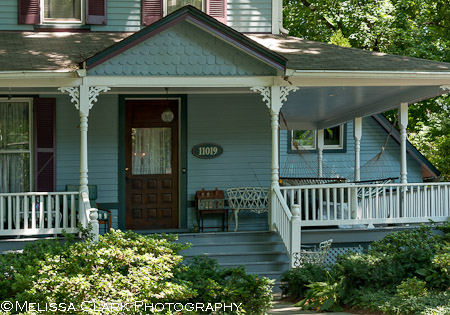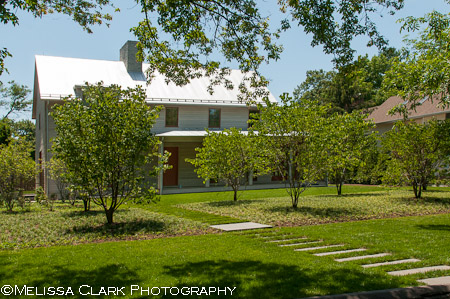An Urban ‘Farmhouse’ and Garden
On June 9th, I visited a newly built house and garden in Garrett Park, Maryland as part of The Cultural Landscape Foundation‘s new program called Garden Dialogues. For two hours, about a dozen of us talked with the site’s architect (Richard Williams), landscape architect (Gregg Bleam), and builder (Abe Sari of Horizon Builders) about the concept for the house and garden (and the relationship between the two), how the owner’s goals were achieved, and materials and process involved in bringing the dream to reality. I should set the stage by explaining that Garrett Park is a neighborhood full of large old (and new) Victorian-style homes complete with spacious front porches and yards with mature, existing trees.

No, this isn’t the Reed house, but one of Garrett Park’s traditional Victorian-style homes, complete with eye-catching paint, big front porch and hammock, and brightly contrasting shutters. A town ordinance encourages renovated and new homes to include front porches.
As the architect and owners explained before we were let loose to wander about on our own, the lot on which the house and landscape now stand was once occupied by an old farmhouse, which burned down several years ago. In 2009, the Reeds purchased the lot and started to look for an architect who would understand their desire for a feeling of tranquility and belonging in this “magical neighborhood.” The resulting house, while distinctly modern, was designed to evoke the sense of a modern farmhouse, including a distinctive front porch. And the plantings, brilliantly designed by Gregg Bleam, a Charlottesville-based landscape architect, are in sync every step of the way.

The Reed house, viewed from the street, pays homage to the old farmhouse that previously stood on the site, with an “orchard” of Cercis canadensis, planted in a rectangle of mondo grass surrounded by lawn.

On the right side of the house, an aggregate driveway, intersected by grass panels, leads to the garage, and the corner steps to the front porch welcome visitors.
Once inside the house, the first view that greets you immediately draws your eye out into the garden.

The view from the Reeds’ front hallway takes in a rectangular water feature crossed by a simple wooden bridge and leads the eye to a panel of Equisetum and then to a group of Amelanchier trees at the end of the garden. A specimen ‘Jane’ magnolia can be seen on the left in front of the serviceberry grove.
The pool is only about 8″ deep (the safety of future grandchildren having dictated the decision on depth). Stacked 1-1/2″ flagstone pavers provide access up and down from the bridge on the grass side. A single specimen ‘Jane’ magnolia of considerable heft is in the lawn area in front of the Amelanchier trees. A row of tall hornbeams surrounds the yard on the left and rear, in front of a simple open-design fence only 4′ tall, chosen to avoid a “walled feeling” while provide necessary screening. The simplicity of the design is elegant, reminiscent of a Dan Kiley landscape (Bleam trained with Kiley early in his career, and the design kinship is evident – and impressive.)

Architect Richard Williams discussing the design of the Reed house. A panel of Equisetum, noted for its sculptural qualities, is seen left front.

The Reed house has been LEED certified, both for the house itself and the garden. The roof, made of a type of galvanized aluminum designed to deflect solar rays, also suggests that of the farmhouse that once occupied the site. The patio area near left is composed of thermal bluestone with joints designed to allow rainwater to percolate into underground drainage collection and dispersal “dry wells.”
It is not often that clients are foresighted enough to understand the importance of bringing a landscape architect into the design process while the house is on the drawing boards. When they do, the relationship between interior and exterior and materials used both places, and the importance of views, can be exploited to the maximum. And when designers like me have the opportunity to hear from clients and the creators of their visions in a dialogue like the one I experienced Saturday, everyone is the richer. I look forward to attending more of these events – and hopefully of seeing more of Bleam’s and Williams’ work. It’s inspiring.
Explore posts in the same categories: Environment, landscape, Landscape design solutions, photographyTags: D300, hardscape, Nikon 24-120mm f/4, photography, plants, polarizer, screening, The Cultural Landscape Foundation
You can comment below, or link to this permanent URL from your own site.
June 16, 2012 at 2:27 am
Fantastic shots ! Really amazing! =)
June 18, 2012 at 6:45 pm
Thank you – I always enjoy hearing from other photographers. The day was extremely sunny and the tour was in the afternoon so shooting conditions were not ideal, hence my use of a polarizer on all the outdoor shots.
June 16, 2012 at 7:02 am
Very nice post, Melissa. Good to meet you (finally) at this event.
June 18, 2012 at 6:46 pm
Thanks, Carolyn – I agree it was good to be able to meet in person, and the venue was hard to beat!
June 16, 2012 at 9:11 am
Inspiring, indeed. The explanation of Garrett Park really helps contextualize this setting. I love how the contemporary style can still honor the history and soul of the land and surrounds.
Thanks Melissa!
June 16, 2012 at 2:18 pm
While lovely, the project described makes me question my own participation in landscape design. Yes, the design is an apt response to client needs, resources available, etc. It is also a factitious stage set, placing the client in various “scenarios” entirely divorced from the actual uses being mimicked. The “orchard” of redbuds is emblematic of this dissonant idealization. The landscape is a consumer product, intended to evoke cozy cozy senses of an entirely fake engagement with the land. If this is really an indication of where we are as a culture, then God help us.
June 16, 2012 at 10:53 pm
I’m not understanding how the redbud ‘orchard’ is a dissonant idealization.
What could be more in tune? Acknowledging a modern day aesthetic with a traditional native plant in a configuration that’s pleasing, livable and functional?
Please explain further. Maybe I’m missing something by seeing second hand, but I’d like to understand what you mean.
Explain how the ‘divorcing’ in this design takes place. Client from the environment??
June 17, 2012 at 10:29 pm
Hey Liz, Thanks for your reply. I recognize that as a design project, this one goes some distance to engage the clients with the site in question. As i stated in my first sentence, it is my own participation in the design field i bring into question here. The farmhouse model in this instance once had a real function in the economy and social fabric of the country. An “orchard” was a source of nourishment. I recognize that such a function would not fit in the social daily rhythm of the clients in question. The use of an ornamental and calling it an “orchard” evokes the gardens of the Petit Trianon of Marie Antoinette or the Potemkin Villages constructed along rail lines for the amusement of the Czars. There is an ersatz quality to calling an orchard a copse of trees that produce useless little pods. It’s okay, your project succeeds well by most current definitions. But, once again, i feel ill at ease in a society where the resources of the well off go to creating the ambiance of nostalgic uses using monetary resources which are elided or ignored by the terms of the project. This is a sterile exercise in imitating real American places to frame a measure of bland, bourgeois comfort.
June 18, 2012 at 6:37 pm
I would like to clarify that the landscape architect’s use of the “orchard” reference was only a minor aspect of his description of the influences at work in the concept involved in this project.
One could argue (as others have in the past) that all gardens are in some manner artificial. We impose our (and our clients’) visions on nature. I am not a serious student (or for that matter, devotee) of minimalist landscapes as a rule, but in this instance I found this site to be one that spoke to me and made me feel a sense of simplicity and peace rather than artificiality.
Thanks for sharing your reactions. They are thought-provoking and worth considering.
June 18, 2012 at 2:58 pm
It’s a beautifully proportioned design, and I understand the practicality of redbuds and mondo grass, but I love to see that first Reed house photo with (even) crabapples and unmowed turf (instead of the mondo). I imagine children running under the trees, but can you run on mondo grass?
June 18, 2012 at 6:43 pm
Cindy, I thought about crabapples too after the fact. But although they are beautiful in spring, they can be susceptible to fireblight and if one tree gets it, they would all turn diseased and ugly very quickly. As for the mondo grass, I think it will be soft to run around on, it does take foot traffic, and avoids the issue of having to mow up to the base of a lot of trees planted in lawn. For what it’s worth, Gregg Bleam said he had considered the idea of having a simple “meadow” in place of a front lawn but feared the Garrett Park powers that be (which had to approve the plan within certain parameters, I think) would not have gone for it. And meadows are hardly low-maintenance, which was a concern of the owners.
July 4, 2012 at 7:32 am
Of course you’re right and, goodness knows, there’s nothing wrong with redbuds and mondo grass. I asked myself if it had been called “rectangular arrangement in cercis and mondo,” rather than “orchard” whether I would have wished for anything else.
Perhaps the planting is just right — while built on old farmland, Garret Park was never a community of farmers, but a planned suburb from its beginning in 1886. (We looked at a house there in the ’90s, and it is charming.)
Happy 4th of July!
June 24, 2012 at 5:27 pm
Reblogged this on My Feng Shui Garden and commented:
Beautiful combination of conceptual thinking, craftsmanship and creation of a lovely new home and garden.
Let’s work and create together!